密码编码学和网络安全(第五版)答案解析
- 格式:doc
- 大小:783.50 KB
- 文档页数:100

密码编码学与网络安全课后习题答案全YUKI was compiled on the morning of December 16, 2020密码编码学与网络安全(全)1.1 什么是OSI安全体系结构?OSI安全体系结构是一个架构,它为规定安全的要求和表征满足那些要求的途径提供了系统的方式。
该文件定义了安全攻击、安全机理和安全服务,以及这些范畴之间的关系。
1.2 被动安全威胁和主动安全威胁之间的差别是什么?被动威胁必须与窃听、或监控、传输发生关系。
电子邮件、文件的传送以及用户/服务器的交流都是可进行监控的传输的例子。
主动攻击包括对被传输的数据加以修改,以及试图获得对计算机系统未经授权的访问。
1.4验证:保证通信实体之一,它声称是。
访问控制:防止未经授权使用的资源(即,谁可以拥有对资源的访问,访问在什么条件下可能发生,那些被允许访问的资源做这个服务控制)。
数据保密:保护数据免受未经授权的披露。
数据完整性:保证接收到的数据是完全作为经授权的实体(即包含任何修改,插入,删除或重播)发送。
不可否认性:提供保护反对否认曾参加全部或部分通信通信中所涉及的实体之一。
可用性服务:系统属性或访问和经授权的系统实体的需求,可用的系统资源,根据系统(即系统是可用的,如果它提供服务,根据系统设计,只要用户要求的性能指标它们)。
第二章1.什么是对称密码的本质成分?明文、加密算法、密钥、密文、解密算法。
4.分组密码和流密码的区别是什么?流密码是加密的数字数据流的一个位或一次一个字节。
块密码是明文块被视为一个整体,用来产生一个相同长度的密文块......分组密码每次处理输入的一组分组,相应的输出一组元素。
流密码则是连续地处理输入元素,每次输出一个元素。
6.列出并简要定义基于攻击者所知道信息的密码分析攻击类型。
惟密文攻击:只知道要解密的密文。
这种攻击一般是试遍所有可能的密钥的穷举攻击,如果密钥空间非常大,这种方法就不太实际。
因此攻击者必须依赖于对密文本身的分析,这一般要运用各种统计方法。

密码编码学与网络安全第五版密码编码学与网络安全是现代信息保密与通信安全的基础理论。
其研究内容包括加密、解密算法的设计与分析,密码系统的实现与安全性评估,网络安全协议的设计与分析等。
在网络时代,密码编码学与网络安全的研究显得尤为重要。
密码编码学主要包括对消息的加密与解密。
加密是将明文消息转化为密文消息的过程,解密是将密文消息还原为明文消息的过程。
密码算法的设计应具有安全性、可靠性和效率性。
安全性是指密文不能被未授权的人解密,可靠性是指密文在传输、存储和处理过程中不会出现错误,效率性是指算法需要较低的时间和空间成本。
密码系统的实现需要考虑多种因素。
首先是密钥的管理,密钥是加密与解密过程中必不可少的要素,因此密钥的生成、分发、存储和更新等都需要考虑。
其次是密码系统的可靠性与安全性评估,对密码系统的实施,应进行相关的评估与测试,以确保其在现实应用中的可靠性与安全性。
最后,密码系统的实施还需要考虑与其他系统的兼容性,以实现不同系统之间的通信与数据交换。
网络安全协议设计与分析是密码编码学与网络安全的重要研究内容之一。
网络安全协议是保证网络信息安全的关键,它基于密码学算法与协议的设计与实现。
网络安全协议的设计目标是实现认证、机密性、完整性和不可否认性等安全性质,并确保这些性质在网络通信中得以维护。
密码编码学与网络安全既有其理论研究的基础,也有其实际应用的重要性。
随着信息技术的不断发展,网络安全问题也越发凸显。
密码编码学与网络安全的研究对于保护个人隐私,防止信息泄露,维护国家安全等方面起到了重要作用。
综上所述,密码编码学与网络安全是现代信息保密与通信安全的基础理论。
其应用领域广泛,包括信息加密,网络安全协议的设计与分析等。
密码编码学与网络安全的研究对于保障个人隐私,防止信息泄露,维护国家安全等方面具有重要意义。
在信息时代,我们需要加强对密码编码学与网络安全的研究与实践,以应对不断增长的网络安全挑战。
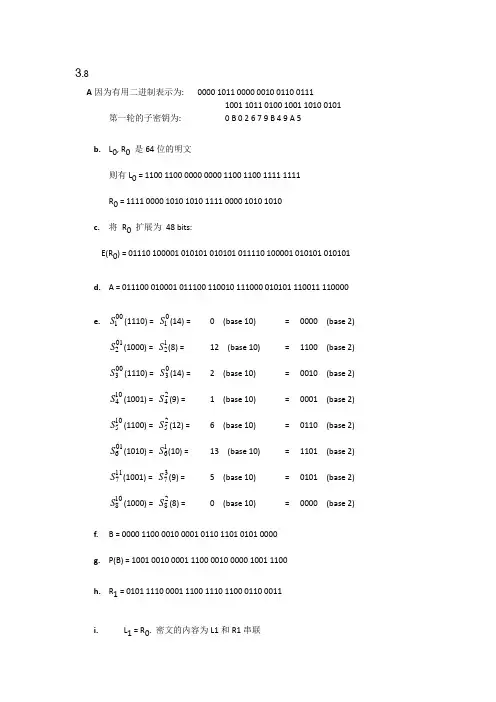
3.8A因为有用二进制表示为: 0000 1011 0000 0010 0110 01111001 1011 0100 1001 1010 0101 第一轮的子密钥为: 0 B 0 2 6 7 9 B 4 9 A 5b. L0, R0是64位的明文则有L0 = 1100 1100 0000 0000 1100 1100 1111 1111R0 = 1111 0000 1010 1010 1111 0000 1010 1010c. 将R0扩展为48 bits:E(R0) = 01110 100001 010101 010101 011110 100001 010101 010101d. A = 011100 010001 011100 110010 111000 010101 110011 110000e. S100(1110) = S10(14) = 0 (base 10) = 0000 (base 2)S201(1000) = S21(8) = 12 (base 10) = 1100 (base 2)S300(1110) = S30(14) = 2 (base 10) = 0010 (base 2)S410(1001) = S42(9) = 1 (base 10) = 0001 (base 2)S510(1100) = S52(12) = 6 (base 10) = 0110 (base 2)S601(1010) = S61(10) = 13 (base 10) = 1101 (base 2)S711(1001) = S73(9) = 5 (base 10) = 0101 (base 2)S810(1000) = S82(8) = 0 (base 10) = 0000 (base 2)f. B = 0000 1100 0010 0001 0110 1101 0101 0000g. P(B) = 1001 0010 0001 1100 0010 0000 1001 1100h. R1 = 0101 1110 0001 1100 1110 1100 0110 0011i.L1 = R0. 密文的内容为L1和R1串联3.10a.从内到外的计算过程T16(L15|| R15) = L16|| R16T17(L16|| R16) = R16|| L16IP [IP–1 (R16|| L16)] = R16|| L16TD1(R16|| L16) = R15|| L15b.T16(L15|| R15) = L16|| R16IP [IP–1 (L16|| R16)] = L16|| R16TD1(R16 || L16) = R16|| L16⊕ f(R16, K16)≠ L15|| R151≤I≤128,字符串c1{0,1}128字符串,其第i位为1其余各位都为0获取这128密文解密。
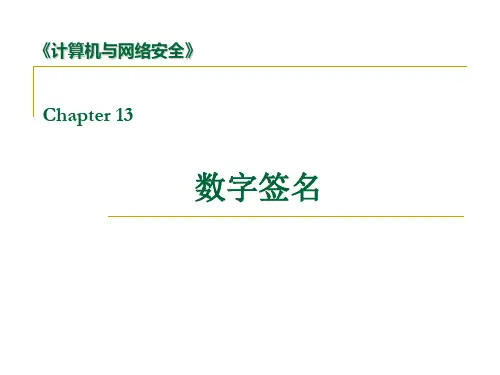
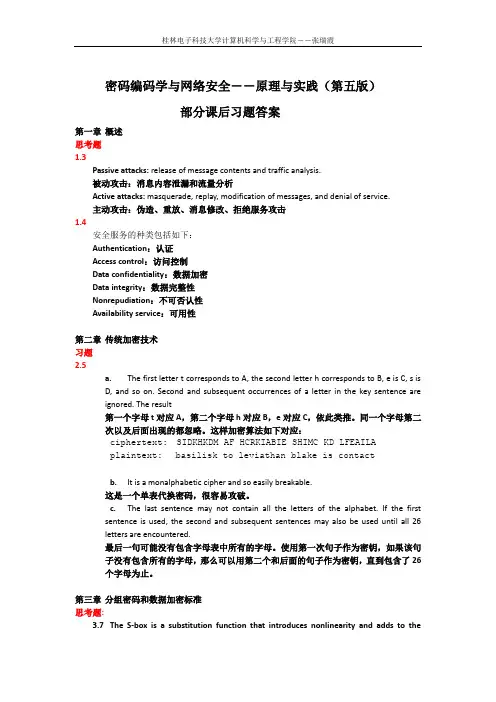

密码编码学与网络安全课后习题答案全Document number【SA80SAB-SAA9SYT-SAATC-SA6UT-SA18】密码编码学与网络安全(全)什么是OSI安全体系结构?OSI安全体系结构是一个架构,它为规定安全的要求和表征满足那些要求的途径提供了系统的方式。
该文件定义了安全攻击、安全机理和安全服务,以及这些范畴之间的关系。
被动安全威胁和主动安全威胁之间的差别是什么?被动威胁必须与窃听、或监控、传输发生关系。
电子邮件、文件的传送以及用户/服务器的交流都是可进行监控的传输的例子。
主动攻击包括对被传输的数据加以修改,以及试图获得对计算机系统未经授权的访问。
验证:保证通信实体之一,它声称是。
访问控制:防止未经授权使用的资源(即,谁可以拥有对资源的访问,访问在什么条件下可能发生,那些被允许访问的资源做这个服务控制)。
数据保密:保护数据免受未经授权的披露。
数据完整性:保证接收到的数据是完全作为经授权的实体(即包含任何修改,插入,删除或重播)发送。
不可否认性:提供保护反对否认曾参加全部或部分通信通信中所涉及的实体之一。
可用性服务:系统属性或访问和经授权的系统实体的需求,可用的系统资源,根据系统(即系统是可用的,如果它提供服务,根据系统设计,只要用户要求的性能指标它们)。
第二章1.什么是对称密码的本质成分?明文、加密算法、密钥、密文、解密算法。
4.分组密码和流密码的区别是什么?流密码是加密的数字数据流的一个位或一次一个字节。
块密码是明文块被视为一个整体,用来产生一个相同长度的密文块......分组密码每次处理输入的一组分组,相应的输出一组元素。
流密码则是连续地处理输入元素,每次输出一个元素。
6.列出并简要定义基于攻击者所知道信息的密码分析攻击类型。
惟密文攻击:只知道要解密的密文。
这种攻击一般是试遍所有可能的密钥的穷举攻击,如果密钥空间非常大,这种方法就不太实际。
因此攻击者必须依赖于对密文本身的分析,这一般要运用各种统计方法。

密码编码学与网络安全答案密码编码学是一门研究如何保护密码和信息安全的学科。
在网络安全中,密码编码学起着至关重要的作用。
下面我将就密码编码学与网络安全的关系进行探讨。
首先,密码编码学是网络安全的基础。
在网络通信中,要确保信息的机密性和完整性,就需要使用密码技术进行加密和解密。
密码编码学提供了各种加密算法,如对称加密算法和非对称加密算法,以及哈希函数等。
这些算法可以对通信数据进行加密,保护数据的机密性。
同时,密码编码学还可以使用数字签名和数字证书来验证通信双方的身份和数据的完整性。
这些技术都是网络安全的关键组成部分,没有密码编码学的支持,网络安全将无法实现。
其次,密码编码学能够防止黑客入侵和信息泄露。
在网络安全中,黑客入侵是常见的威胁之一。
黑客可以通过各种手段获取用户的密码和敏感信息,从而侵犯用户的隐私和安全。
密码编码学可以通过加密算法保护用户的密码,使黑客无法轻易获取用户的真实密码。
此外,密码编码学还可以使用数字证书和数字签名技术,防止黑客进行身份伪造和数据篡改,从而保护网络中的数据安全。
最后,密码编码学可以促进网络安全的研究和发展。
网络安全是一个不断变化和发展的领域,新的威胁和攻击手段不断出现。
密码编码学不仅提供了有效的加密算法和认证技术,还为解决网络安全问题提供了一种思维模式和解决方法。
研究密码编码学可以帮助人们深入理解网络安全的原理和技术,提高对网络安全风险的识别和应对能力,促进网络安全技术的研究和发展。
综上所述,密码编码学对于网络安全具有重要的意义。
它不仅为网络通信提供了保护安全的手段,还能够防止黑客入侵和信息泄露,并促进网络安全的研究和发展。
在日益复杂和多样化的网络安全威胁面前,密码编码学的作用将愈发重要。
为了提高网络安全水平,我们应该加强对密码编码学的学习和应用,不断完善网络安全技术体系,确保网络的稳定和安全运行。
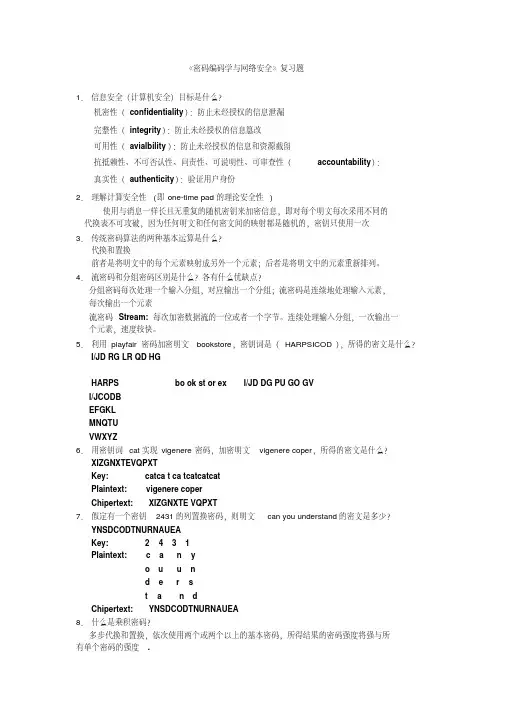
《密码编码学与网络安全》复习题1.信息安全(计算机安全)目标是什么?机密性(confidentiality):防止未经授权的信息泄漏完整性(integrity):防止未经授权的信息篡改可用性(avialbility):防止未经授权的信息和资源截留抗抵赖性、不可否认性、问责性、可说明性、可审查性(accountability):真实性(authenticity):验证用户身份2.理解计算安全性(即one-time pad的理论安全性)使用与消息一样长且无重复的随机密钥来加密信息,即对每个明文每次采用不同的代换表不可攻破,因为任何明文和任何密文间的映射都是随机的,密钥只使用一次3.传统密码算法的两种基本运算是什么?代换和置换前者是将明文中的每个元素映射成另外一个元素;后者是将明文中的元素重新排列。
4.流密码和分组密码区别是什么?各有什么优缺点?分组密码每次处理一个输入分组,对应输出一个分组;流密码是连续地处理输入元素,每次输出一个元素流密码Stream: 每次加密数据流的一位或者一个字节。
连续处理输入分组,一次输出一个元素,速度较快。
5.利用playfair密码加密明文bookstore,密钥词是(HARPSICOD),所得的密文是什么?I/JD RG LR QD HGHARPS bo ok st or ex I/JD DG PU GO GVI/JCODBEFGKLMNQTUVWXYZ6.用密钥词cat实现vigenere密码,加密明文vigenere coper,所得的密文是什么?XIZGNXTEVQPXTKey: catca t ca tcatcatcatPlaintext: vigenere coperChipertext: XIZGNXTE VQPXT7.假定有一个密钥2431的列置换密码,则明文can you understand的密文是多少?YNSDCODTNURNAUEAKey: 2 4 3 1Plaintext: c a n yo u u nd e r st a n dChipertext: YNSDCODTNURNAUEA8.什么是乘积密码?多步代换和置换,依次使用两个或两个以上的基本密码,所得结果的密码强度将强与所有单个密码的强度.9.混淆和扩散的区别是什么?扩散(Diffusion):明文的统计结构被扩散消失到密文的,使得明文和密文之间的统计关系尽量复杂.即让每个明文数字尽可能地影响多个密文数字混淆(confusion):使得密文的统计特性与密钥的取值之间的关系尽量复杂,阻止攻击者发现密钥10.Feistel密码中每轮发生了什么样的变化?将输入分组分成左右两部分。
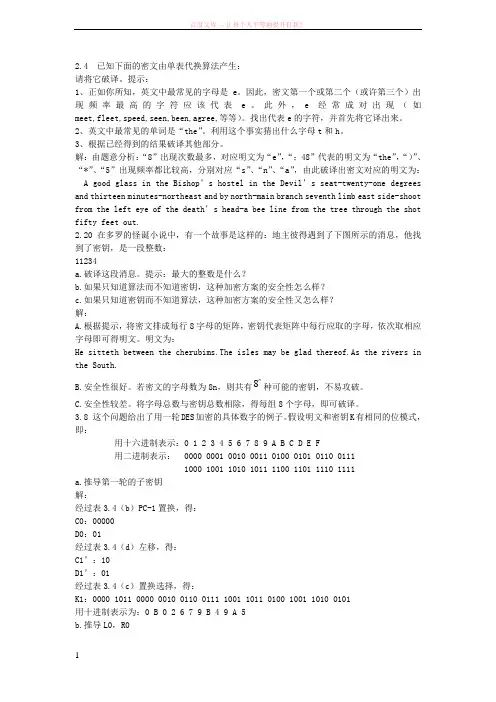
2.4 已知下面的密文由单表代换算法产生:请将它破译。
提示:1、正如你所知,英文中最常见的字母是e。
因此,密文第一个或第二个(或许第三个)出现频率最高的字符应该代表e。
此外,e经常成对出现(如meet,fleet,speed,seen,been,agree,等等)。
找出代表e的字符,并首先将它译出来。
2、英文中最常见的单词是“the”。
利用这个事实猜出什么字母t和h。
3、根据已经得到的结果破译其他部分。
解:由题意分析:“8”出现次数最多,对应明文为“e”,“;48”代表的明文为“the”,“)”、“*”、“5”出现频率都比较高,分别对应“s”、“n”、“a”,由此破译出密文对应的明文为: A good glass in the Bishop’s hostel in the Devil’s seat-twenty-one degrees and thirteen minutes-northeast and by north-main branch seventh limb east side-shoot from the left eye of the death’s head-a bee line from the tree through the shot fifty feet out.2.20 在多罗的怪诞小说中,有一个故事是这样的:地主彼得遇到了下图所示的消息,他找到了密钥,是一段整数:11234a.破译这段消息。
提示:最大的整数是什么?b.如果只知道算法而不知道密钥,这种加密方案的安全性怎么样?c.如果只知道密钥而不知道算法,这种加密方案的安全性又怎么样?解:A.根据提示,将密文排成每行8字母的矩阵,密钥代表矩阵中每行应取的字母,依次取相应字母即可得明文。
明文为:He sitteth between the cherubims.The isles may be glad thereof.As the rivers in the South.B.安全性很好。
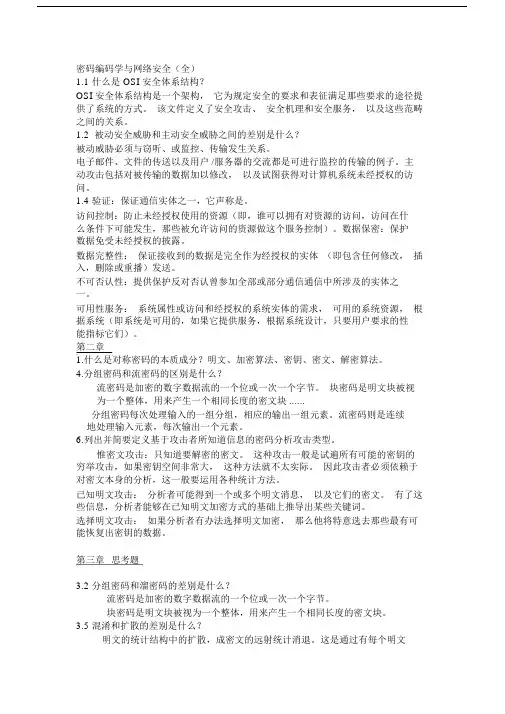
密码编码学与网络安全(全)1.1 什么是 OSI 安全体系结构?OSI 安全体系结构是一个架构,它为规定安全的要求和表征满足那些要求的途径提供了系统的方式。
该文件定义了安全攻击、安全机理和安全服务,以及这些范畴之间的关系。
1.2 被动安全威胁和主动安全威胁之间的差别是什么?被动威胁必须与窃听、或监控、传输发生关系。
电子邮件、文件的传送以及用户 /服务器的交流都是可进行监控的传输的例子。
主动攻击包括对被传输的数据加以修改,以及试图获得对计算机系统未经授权的访问。
1.4 验证:保证通信实体之一,它声称是。
访问控制:防止未经授权使用的资源(即,谁可以拥有对资源的访问,访问在什么条件下可能发生,那些被允许访问的资源做这个服务控制)。
数据保密:保护数据免受未经授权的披露。
数据完整性:保证接收到的数据是完全作为经授权的实体(即包含任何修改,插入,删除或重播)发送。
不可否认性:提供保护反对否认曾参加全部或部分通信通信中所涉及的实体之一。
可用性服务:系统属性或访问和经授权的系统实体的需求,可用的系统资源,根据系统(即系统是可用的,如果它提供服务,根据系统设计,只要用户要求的性能指标它们)。
第二章1.什么是对称密码的本质成分?明文、加密算法、密钥、密文、解密算法。
4.分组密码和流密码的区别是什么?流密码是加密的数字数据流的一个位或一次一个字节。
块密码是明文块被视为一个整体,用来产生一个相同长度的密文块 ......分组密码每次处理输入的一组分组,相应的输出一组元素。
流密码则是连续地处理输入元素,每次输出一个元素。
6.列出并简要定义基于攻击者所知道信息的密码分析攻击类型。
惟密文攻击:只知道要解密的密文。
这种攻击一般是试遍所有可能的密钥的穷举攻击,如果密钥空间非常大,这种方法就不太实际。
因此攻击者必须依赖于对密文本身的分析,这一般要运用各种统计方法。
已知明文攻击:分析者可能得到一个或多个明文消息,以及它们的密文。
有了这些信息,分析者能够在已知明文加密方式的基础上推导出某些关键词。

谢希仁计算机网络第五课后习题答案第七章网络安全————————————————————————————————作者:————————————————————————————————日期:第七章网络安全7-01 计算机网络都面临哪几种威胁?主动攻击和被动攻击的区别是什么?对于计算机网络的安全措施都有哪些?答:计算机网络面临以下的四种威胁:截获(interception),中断(interruption),篡改(modification),伪造(fabrication)。
网络安全的威胁可以分为两大类:即被动攻击和主动攻击。
主动攻击是指攻击者对某个连接中通过的PDU进行各种处理。
如有选择地更改、删除、延迟这些PDU。
甚至还可将合成的或伪造的PDU送入到一个连接中去。
主动攻击又可进一步划分为三种,即更改报文流;拒绝报文服务;伪造连接初始化。
被动攻击是指观察和分析某一个协议数据单元PDU而不干扰信息流。
即使这些数据对攻击者来说是不易理解的,它也可通过观察PDU的协议控制信息部分,了解正在通信的协议实体的地址和身份,研究PDU的长度和传输的频度,以便了解所交换的数据的性质。
这种被动攻击又称为通信量分析。
还有一种特殊的主动攻击就是恶意程序的攻击。
恶意程序种类繁多,对网络安全威胁较大的主要有以下几种:计算机病毒;计算机蠕虫;特洛伊木马;逻辑炸弹。
对付被动攻击可采用各种数据加密动技术,而对付主动攻击,则需加密技术与适当的鉴别技术结合。
7-02 试解释以下名词:(1)重放攻击;(2)拒绝服务;(3)访问控制;(4)流量分析;(5)恶意程序。
答:(1)重放攻击:所谓重放攻击(replay attack)就是攻击者发送一个目的主机已接收过的包,来达到欺骗系统的目的,主要用于身份认证过程。
(2)拒绝服务:DoS(Denial of Service)指攻击者向因特网上的服务器不停地发送大量分组,使因特网或服务器无法提供正常服务。
密码学与信息安全作业(第一次)第一章思考題1.1OSI安全框架是什麽。
OSI安全框架即X.800,对安全人员来说,OSI安全框架是提供安全的一种组织方法。
OSI安全框架主要关注安全攻击,安全机制和安全服务。
安全攻击:任何危及信息安全系统的行为安全机制:用来检测,阻止攻击或者从攻击状态恢复到正常状态的过程(或通信服务或实现该过程的设备)安全服务:加强数据处理系统和信息传输的安全性的一种处理过程或通信服务。
其目的在于利用一种或多种安全机制进行反攻击。
备注:某些文献中,威胁和攻击差不多用来指相同的事情。
威胁:破坏安全的潜在可能,在环境,能力,行为或事件允许的情况下,他们会破坏安全,造成危害。
也就是说,威胁是脆弱性被利用而可能带来的危害。
攻击:对系统安全的攻击,它来源于一种具有智能的威胁,也就是说,有意违反安全服务和侵犯系统安全策略的(特别是在方法或技巧方面的)智能行为。
1.3列出并简短地定义被动和主动安全攻击的种类。
被动攻击:试图了解或利用系统的信息但不影响系统的资源,特性是对传输进行窃听和检测,目标是获得传输的信息,信息内容泄露和流量攻击就是两种被动攻击的方式,由于不涉及对数据的更改,所以很难察觉。
因此被动攻击的重点是预防而不是检测。
主动攻击:试图改变系统的资源或影响系统的运作。
主要包括对数据的修改和伪造数据流,主要有伪装,重播,消息修改和拒绝服务四类。
伪装是某实体假装别的实体,重播是指将获得的信息再次发送以产生非授权的效果。
消息修改是指修改和发消息的一部分或延迟消息的传输或改变消息的顺序以获得非授权效果。
拒绝服阻止或禁止对通信设施的正常使用或管理,这种攻击可能具有具体的目标。
主动攻击难以绝对预防但容易检测。
1.4列出并简短定义安全服务的种类。
安全服务:系统提供的对系统资源进行特殊保护的处理或通信服务,安全服务通过安全机制来实现安全策略。
X.800将这些服务分为5类共14个特定服务:1)认证:保证通信的实体是它所声称的实体。
计算机网络安全基础(第5版)习题参考答案第1章习题:1.举出使用分层协议的两条理由?1.通过分层,允许各种类型网络硬件和软件相互通信,每一层就像是与另一台计算机对等层通信;2.各层之间的问题相对独立,而且容易分开解决,无需过多的依赖外部信息;同时防止对某一层所作的改动影响到其他的层;3.通过网络组件的标准化,允许多个提供商进行开发。
2.有两个网络,它们都提供可靠的面向连接的服务。
一个提供可靠的字节流,另一个提供可靠的比特流。
请问二者是否相同?为什么?不相同。
在报文流中,网络保持对报文边界的跟踪;而在字节流中,网络不做这样的跟踪。
例如,一个进程向一条连接写了1024字节,稍后又写了另外1024字节。
那么接收方共读了2048字节。
对于报文流,接收方将得到两个报文,、每个报文1024字节。
而对于字节流,报文边界不被识别。
接收方把全部的2048字节当作一个整体,在此已经体现不出原先有两个不同的报文的事实。
3.举出OSI参考模型和TCP/IP参考模型的两个相同的方面和两个不同的方面。
OSI模型(开放式系统互连参考模型):这个模型把网络通信工作分为7层,他们从低到高分别是物理层、数据链路层、网络层、传输层、会话层、表示层和应用层。
第一层到第三层属于低三层,负责创建网络通信链路;第四层到第七层为高四层,具体负责端到端的数据通信。
每层完成一定的功能,每层都直接为其上层提供服务,并且所有层次都互相支持。
TCP/IP模型只有四个层次:应用层、传输层、网络层、网络接口层。
与OSI功能相比,应用层对应的是OSI的应用层、表示层、会话层;网络接口层对应着OSI的数据链路层和物理层。
两种模型的不同之处主要有:(1) TCP/IP在实现上力求简单高效,如IP层并没有实现可靠的连接,而是把它交给了TCP层实现,这样保证了IP层实现的简练性。
OSI参考模型在各层次的实现上有所重复。
(2) TCP/IP结构经历了十多年的实践考验,而OSI参考模型只是人们作为一种标准设计的;再则TCP/IP有广泛的应用实例支持,而OSI参考模型并没有。
密码学第五版部分课后答案已知下面的密文单表代换算法产生:请将它破译。
提示:1、正如你所知,英文中最常见的字母是e。
因此,密文第一个或第二个出现频率最高的字符应该代表e。
此外,e 经常成对出现。
找出代表e的字符,并首先将它译出来。
2、英文中最常见的单词是“the”。
利用这个事实猜出什么字母t和h。
3、根据已经得到的结果破译其他部分。
解:题意分析:“8”出现次数最多,对应明文为“e”,“;48”代表的明文为“the”,“)”、“*”、“5”出现频率都比较高,分别对应“s”、“n”、“a”,此破译出密文对应的明文为: A good glass in the Bishop’s hostel in the Devil’s seat-twenty-one degrees and thirteen minutes-northeast and by north-main branch seventh limb east side-shoot from the left eye of the death’s head-a bee line from the tree through the shot fifty feet out.在多罗的怪诞小说中,有一个故事是这样的:地主彼得遇到了下图所示的消息,他找到了密钥,是一段整数:7876565434321123434565678788787656543432112343456567878878765654343211234 a.破译这段消息。
提示:最大的整数是什么?b.如果只知道算法而不知道密钥,这种加密方案的安全性怎么样?c.如果只知道密钥而不知道算法,这种加密方案的安全性又怎么样?解:A.根据提示,将密文排成每行8字母的矩阵,密钥代表矩阵中每行应取的字母,依次取相应字母即可得明文。
明文为:He sitteth between the isles may be glad the rivers in the South.B.安全性很好。
密码编码学与网络安全第五版《密码编码学与网络安全》是一本全面介绍密码学和网络安全的经典教材。
本书分为11章,涵盖了密码学的基础知识、对称加密算法、公钥加密算法、哈希函数、数字签名、安全协议、网络安全等内容。
在密码学的基础知识章节中,书中介绍了密码学的基本概念、加密和解密的基本原理、安全性要求和攻击模型等内容。
同时,还介绍了一些常用的密码学术语和符号,为后续章节的学习做好铺垫。
对称加密算法是密码学中最简单和最早可实现的算法之一。
在本书的对称加密算法章节中,作者介绍了几种经典的对称加密算法,包括凯撒密码、DES和AES等。
对于每种算法,作者都详细介绍了其原理、算法流程以及安全性分析等内容。
公钥加密算法是密码学中的另一项重要技术。
在本书的公钥加密算法章节中,作者介绍了RSA和椭圆曲线密码算法等常用的公钥加密算法。
对于每种算法,作者都详细介绍了其原理、算法流程以及安全性分析等内容。
哈希函数是密码学中常用的一种算法。
在本书的哈希函数章节中,作者介绍了一些常用的哈希函数,如MD5和SHA-1等。
对于每种哈希函数,作者都介绍了其原理、算法流程以及安全性分析等内容。
数字签名是密码学中的一项重要技术,用于保证消息的完整性和身份认证。
在本书的数字签名章节中,作者介绍了数字签名的基本原理、几种常用的数字签名算法,如RSA和DSA等。
作者还介绍了数字证书的概念和使用方法,以及证书机构的信任模型等内容。
安全协议是网络安全中的重要组成部分。
在本书的安全协议章节中,作者介绍了一些常用的安全协议,如SSL/TLS协议和IPSec协议等。
对于每种协议,作者都详细介绍了其原理、实现方法以及安全性分析等内容。
最后,本书还介绍了一些与网络安全相关的内容,如网络攻击和防御、入侵检测和防范、网络安全政策和法律等。
同时,作者还介绍了一些常见的网络攻击技术,如拒绝服务攻击和中间人攻击等。
《密码编码学与网络安全》是一本非常经典的教材,内容全面,深入浅出。
Access control: The prevention of unauthorized use of a resource (i.e., this service controls who can have access to a resource, under what conditions access can occur, and what those accessing the resource are allowed to do).Data confidentiality: The protection of data from unauthorized disclosure.Data integrity: The assurance that data received are exactly as sent by an authorized entity (i.e., contain no modification, insertion, deletion, or replay).Nonrepudiation: Provides protection against denial by one of the entities involved in a communication of having participated in all or part of the communication.Availability service: The property of a system or a system resource being accessible and usable upon demand by an authorized system entity, according to performance specifications for the system (i.e., a system is available if it provides services according to the system design whenever users request them).1.5 See Table 1.3.2.1 Plaintext, encryption algorithm, secret key, ciphertext, decryptionalgorithm.2.2 Permutation and substitution.2.3 One key for symmetric ciphers, two keys for asymmetric ciphers.2.4 A stream cipher is one that encrypts a digital data stream one bit or one byteat a time. A block cipher is one in which a block of plaintext is treated as a whole and used to produce a ciphertext block of equal length.2.5 Cryptanalysis and brute force.2.6 Ciphertext only . One possible attack under these circumstances is thebrute-force approach of trying all possible keys. If the key space is very large, this becomes impractical. Thus, the opponent must rely on an analysis of the ciphertext itself, generally applying various statistical tests to it. Known plaintext. The analyst may be able to capture one or more plaintext messages as well as their encryptions. With this knowledge, the analyst may be able to deduce the key on the basis of the way in which the known plaintext is transformed. Chosen plaintext. If the analyst is able to choose the messages to encrypt, the analyst may deliberately pick patterns that can be expected to reveal the structure of the key.2.7 An encryption scheme is unconditionally secure if the ciphertext generatedby the scheme does not contain enough information to determine uniquely the corresponding plaintext, no matter how much ciphertext is available. An encryption scheme is said to be computationally secure if: (1) the cost of breaking the cipher exceeds the value of the encrypted information, and (2) the time required to break the cipher exceeds the useful lifetime of the information.C HAPTER 2C LASSICAL E NCRYPTION T ECHNIQUESR2.8 The Caesar cipher involves replacing each letter of the alphabet with theletter standing k places further down the alphabet, for k in the range 1 through25.2.9 A monoalphabetic substitution cipher maps a plaintext alphabet to a ciphertextalphabet, so that each letter of the plaintext alphabet maps to a single unique letter of the ciphertext alphabet.2.10 The Playfair algorithm is based on the use of a 5 5 matrix of lettersconstructed using a keyword. Plaintext is encrypted two letters at a time using this matrix.2.11 A polyalphabetic substitution cipher uses a separate monoalphabeticsubstitution cipher for each successive letter of plaintext, depending on a key.2.12 1. There is the practical problem of making large quantities of random keys.Any heavily used system might require millions of random characters on a regular basis. Supplying truly random characters in this volume is asignificant task.2. Even more daunting is the problem of key distribution and protection. Forevery message to be sent, a key of equal length is needed by both sender and receiver. Thus, a mammoth key distribution problem exists.2.13 A transposition cipher involves a permutation of the plaintext letters.2.14 Steganography involves concealing the existence of a message.A NSWERS TO P ROBLEMS2.1 a. No. A change in the value of b shifts the relationship between plaintextletters and ciphertext letters to the left or right uniformly, so that if the mapping is one-to-one it remains one-to-one.b. 2, 4, 6, 8, 10, 12, 13, 14, 16, 18, 20, 22, 24. Any value of a larger than25 is equivalent to a mod 26.c. The values of a and 26 must have no common positive integer factor otherthan 1. This is equivalent to saying that a and 26 are relatively prime, or that the greatest common divisor of a and 26 is 1. To see this, first note that E(a, p) = E(a, q) (0 ≤ p≤ q< 26) if and only if a(p–q) is divisible by 26. 1. Suppose that a and 26 are relatively prime. Then, a(p–q) is not divisible by 26, because there is no way to reduce the fractiona/26 and (p–q) is less than 26. 2. Suppose that a and 26 have a common factor k> 1. Then E(a, p) = E(a, q), if q = p + m/k≠ p.2.2 There are 12 allowable values of a (1, 3, 5, 7, 9, 11, 15, 17, 19, 21, 23,25). There are 26 allowable values of b, from 0 through 25). Thus the totalnumber of distinct affine Caesar ciphers is 12 26 = 312.2.3 Assume that the most frequent plaintext letter is e and the second most frequentletter is t. Note that the numerical values are e = 4; B = 1; t = 19; U = 20.Then we have the following equations:1 = (4a + b) mod 2620 = (19a + b) mod 26Thus, 19 = 15a mod 26. By trial and error, we solve: a = 3.Then 1 = (12 + b) mod 26. By observation, b = 15.2.4 A good glass in the Bishop's hostel in the Devil's seat—twenty-one degreesand thirteen minutes—northeast and by north—main branch seventh limb east side—shoot from the left eye of the death's head— a bee line from the tree through the shot fifty feet out. (from The Gold Bug, by Edgar Allan Poe)2.5 a. The first letter t corresponds to A, the second letter h corresponds toB, e is C, s is D, and so on. Second and subsequent occurrences of a letter in the key sentence are ignored. The resultciphertext: SIDKHKDM AF HCRKIABIE SHIMC KD LFEAILAplaintext: basilisk to leviathan blake is contactb. It is a monalphabetic cipher and so easily breakable.c. The last sentence may not contain all the letters of the alphabet. If thefirst sentence is used, the second and subsequent sentences may also be used until all 26 letters are encountered.2.6The cipher refers to the words in the page of a book. The first entry, 534,refers to page 534. The second entry, C2, refers to column two. The remaining numbers are words in that column. The names DOUGLAS and BIRLSTONE are simply words that do not appear on that page. Elementary! (from The Valley of Fear, by Sir Arthur Conan Doyle)2.7 a.2 8 10 7 9 63 14 5C R Y P T O G A H I4 2 8 1056 37 1 9ISRNG BUTLF RRAFR LIDLP FTIYO NVSEE TBEHI HTETAEYHAT TUCME HRGTA IOENT TUSRU IEADR FOETO LHMETNTEDS IFWRO HUTEL EITDSb. The two matrices are used in reverse order. First, the ciphertext is laidout in columns in the second matrix, taking into account the order dictated by the second memory word. Then, the contents of the second matrix are read left to right, top to bottom and laid out in columns in the first matrix, taking into account the order dictated by the first memory word. Theplaintext is then read left to right, top to bottom.c. Although this is a weak method, it may have use with time-sensitiveinformation and an adversary without immediate access to good cryptanalysis(e.g., tactical use). Plus it doesn't require anything more than paper andpencil, and can be easily remembered.2.8 SPUTNIK2.9 PT BOAT ONE OWE NINE LOST IN ACTION IN BLACKETT STRAIT TWO MILES SW MERESU COVEX CREW OF TWELVE X REQUEST ANY INFORMATION。